Case Study Analysis: Maximum Energy Conversion and Revenue Management
VerifiedAdded on 2023/06/04
|8
|1787
|374
Case Study
AI Summary
This case study examines two distinct scenarios: maximum energy conversion and revenue management. The first part analyzes Hydro's potential adoption of wind power, evaluating its conversion factor, revenue generation, and ethical obligations to shareholders. It delves into the financial implications of investment decisions, including negative NPV projects, and identifies infrastructure challenges. The second part focuses on American Airlines' revenue management strategies, exploring pricing models, ticket types, and the allocation of seats. It assesses the applicability of these strategies across different industries and analyzes the probability of customer behavior, such as balking or seeking service elsewhere. The analysis provides insights into maximizing revenue and making strategic decisions based on historical data and marginal benefit calculations. The assignment uses APA formatting with academic sources.
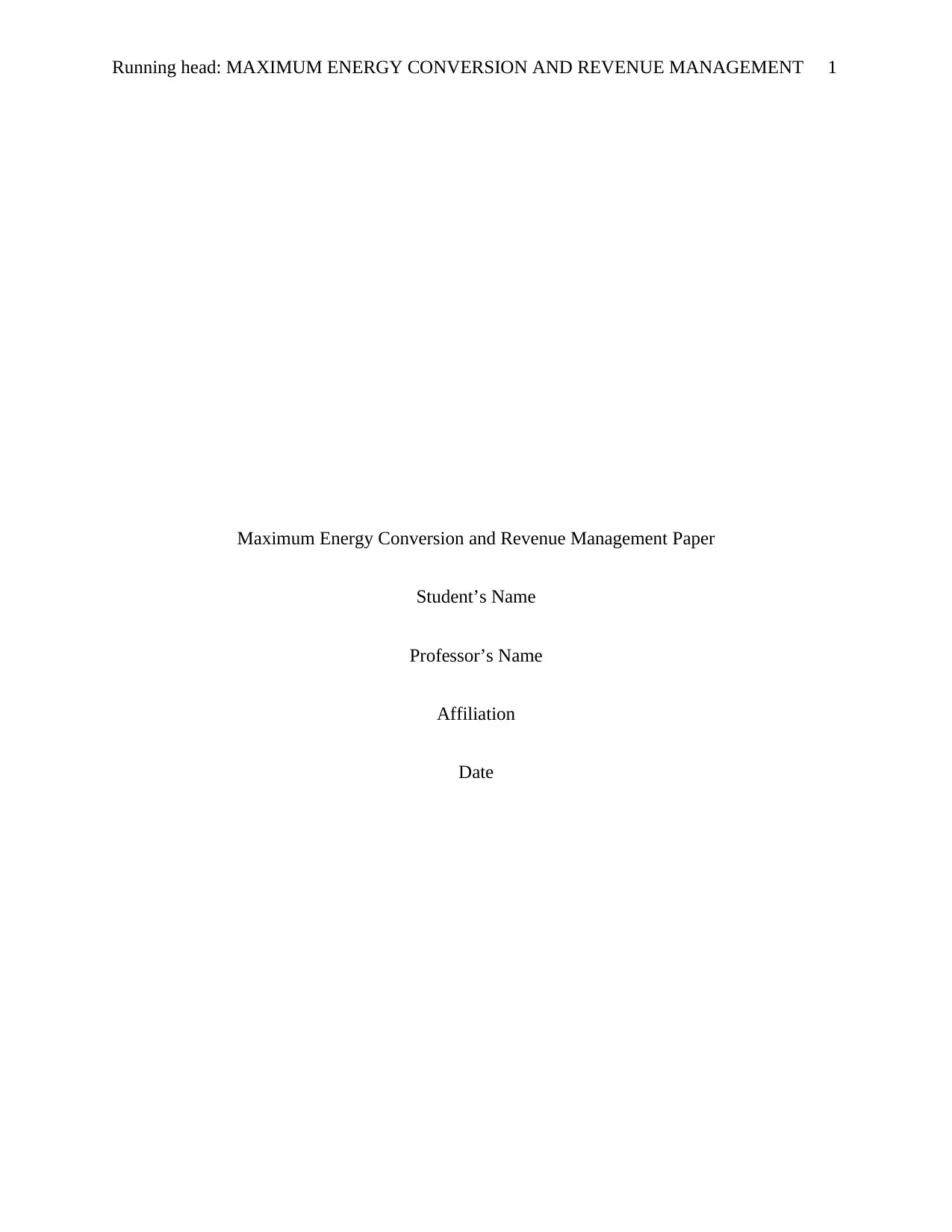
Running head: MAXIMUM ENERGY CONVERSION AND REVENUE MANAGEMENT 1
Maximum Energy Conversion and Revenue Management Paper
Student’s Name
Professor’s Name
Affiliation
Date
Maximum Energy Conversion and Revenue Management Paper
Student’s Name
Professor’s Name
Affiliation
Date
Paraphrase This Document
Need a fresh take? Get an instant paraphrase of this document with our AI Paraphraser

MAXIMUM ENERGY CONVERSION AND REVENUE MANAGEMENT
2
Maximum Energy Conversion and Revenue Management
Hydro Case Study
Question1
Yes, they should adopt wind power because it will result in a maximum energy conversion factor
(CF) of between 60 and 70 percentage per turbine. This is an acceptable CF level given that all
electricity generation process results in the loss of energy. Moreover, the company should expect
the Utsira site project to generate revenue of between $2.66 million and $3.1 million per turbine.
Question 2
The cost of the large-scale turbine is $2.6 million
We already know that at a CF of 70% were are able to generate revenue of $3.1 million
In order to get the break-even point where cost=revenue
We will use proportionality relationships to calculate which CF percentage will yield revenue of
$2.6 million
Therefore:
70%=$3.1 million
x%=$2.6 million
X =70 %∗$ 2.6 million
$ 3.1 million
X=58.71% or 59%
2
Maximum Energy Conversion and Revenue Management
Hydro Case Study
Question1
Yes, they should adopt wind power because it will result in a maximum energy conversion factor
(CF) of between 60 and 70 percentage per turbine. This is an acceptable CF level given that all
electricity generation process results in the loss of energy. Moreover, the company should expect
the Utsira site project to generate revenue of between $2.66 million and $3.1 million per turbine.
Question 2
The cost of the large-scale turbine is $2.6 million
We already know that at a CF of 70% were are able to generate revenue of $3.1 million
In order to get the break-even point where cost=revenue
We will use proportionality relationships to calculate which CF percentage will yield revenue of
$2.6 million
Therefore:
70%=$3.1 million
x%=$2.6 million
X =70 %∗$ 2.6 million
$ 3.1 million
X=58.71% or 59%
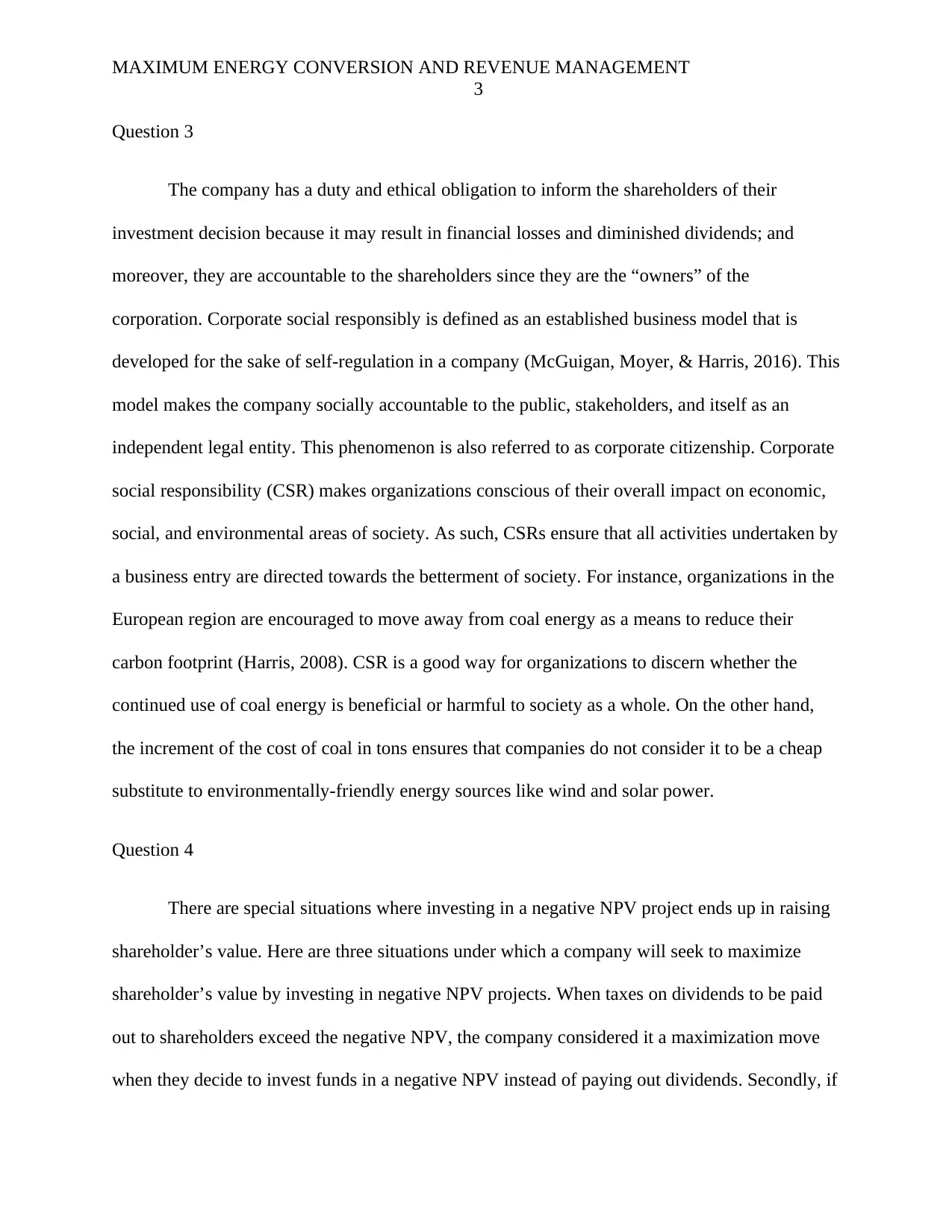
MAXIMUM ENERGY CONVERSION AND REVENUE MANAGEMENT
3
Question 3
The company has a duty and ethical obligation to inform the shareholders of their
investment decision because it may result in financial losses and diminished dividends; and
moreover, they are accountable to the shareholders since they are the “owners” of the
corporation. Corporate social responsibly is defined as an established business model that is
developed for the sake of self-regulation in a company (McGuigan, Moyer, & Harris, 2016). This
model makes the company socially accountable to the public, stakeholders, and itself as an
independent legal entity. This phenomenon is also referred to as corporate citizenship. Corporate
social responsibility (CSR) makes organizations conscious of their overall impact on economic,
social, and environmental areas of society. As such, CSRs ensure that all activities undertaken by
a business entry are directed towards the betterment of society. For instance, organizations in the
European region are encouraged to move away from coal energy as a means to reduce their
carbon footprint (Harris, 2008). CSR is a good way for organizations to discern whether the
continued use of coal energy is beneficial or harmful to society as a whole. On the other hand,
the increment of the cost of coal in tons ensures that companies do not consider it to be a cheap
substitute to environmentally-friendly energy sources like wind and solar power.
Question 4
There are special situations where investing in a negative NPV project ends up in raising
shareholder’s value. Here are three situations under which a company will seek to maximize
shareholder’s value by investing in negative NPV projects. When taxes on dividends to be paid
out to shareholders exceed the negative NPV, the company considered it a maximization move
when they decide to invest funds in a negative NPV instead of paying out dividends. Secondly, if
3
Question 3
The company has a duty and ethical obligation to inform the shareholders of their
investment decision because it may result in financial losses and diminished dividends; and
moreover, they are accountable to the shareholders since they are the “owners” of the
corporation. Corporate social responsibly is defined as an established business model that is
developed for the sake of self-regulation in a company (McGuigan, Moyer, & Harris, 2016). This
model makes the company socially accountable to the public, stakeholders, and itself as an
independent legal entity. This phenomenon is also referred to as corporate citizenship. Corporate
social responsibility (CSR) makes organizations conscious of their overall impact on economic,
social, and environmental areas of society. As such, CSRs ensure that all activities undertaken by
a business entry are directed towards the betterment of society. For instance, organizations in the
European region are encouraged to move away from coal energy as a means to reduce their
carbon footprint (Harris, 2008). CSR is a good way for organizations to discern whether the
continued use of coal energy is beneficial or harmful to society as a whole. On the other hand,
the increment of the cost of coal in tons ensures that companies do not consider it to be a cheap
substitute to environmentally-friendly energy sources like wind and solar power.
Question 4
There are special situations where investing in a negative NPV project ends up in raising
shareholder’s value. Here are three situations under which a company will seek to maximize
shareholder’s value by investing in negative NPV projects. When taxes on dividends to be paid
out to shareholders exceed the negative NPV, the company considered it a maximization move
when they decide to invest funds in a negative NPV instead of paying out dividends. Secondly, if
⊘ This is a preview!⊘
Do you want full access?
Subscribe today to unlock all pages.

Trusted by 1+ million students worldwide
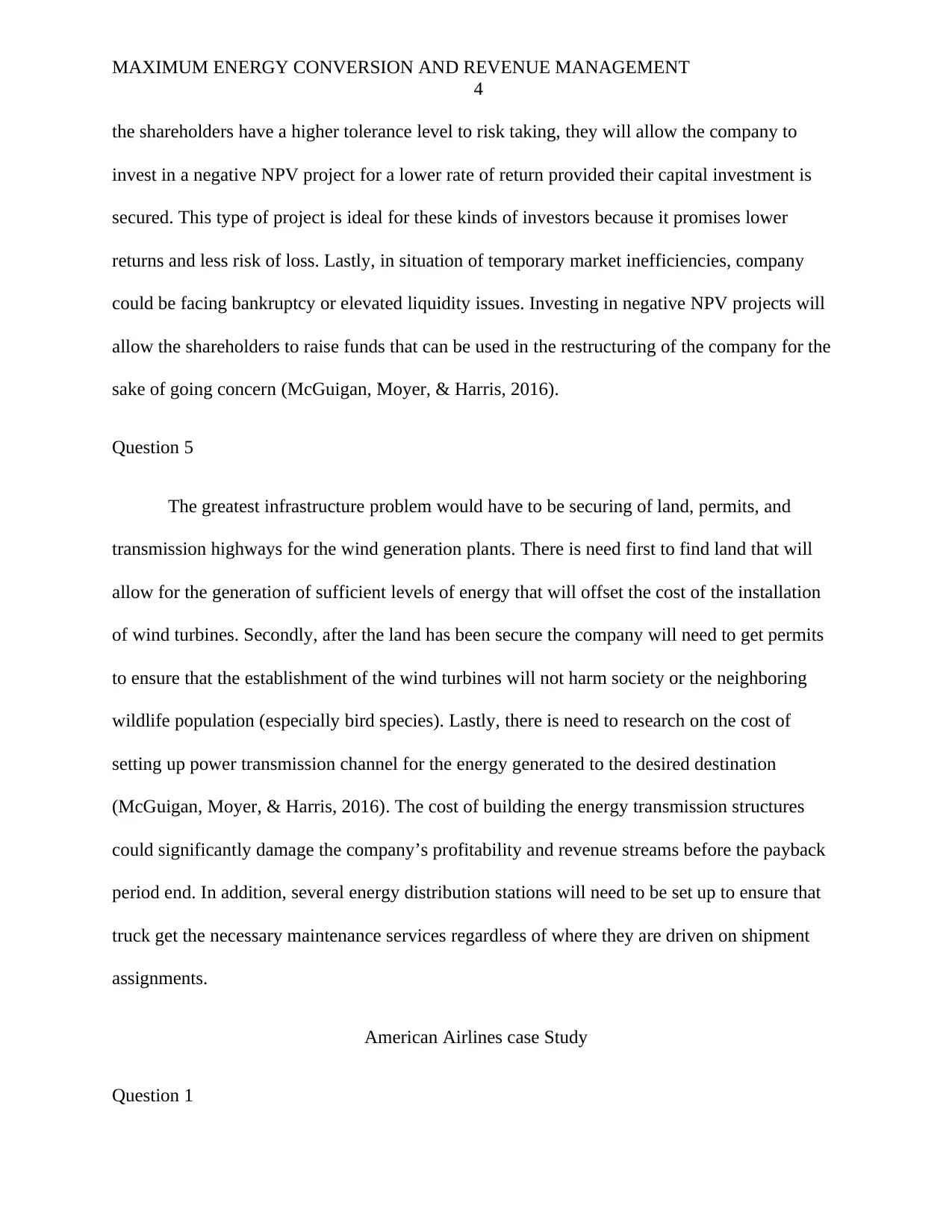
MAXIMUM ENERGY CONVERSION AND REVENUE MANAGEMENT
4
the shareholders have a higher tolerance level to risk taking, they will allow the company to
invest in a negative NPV project for a lower rate of return provided their capital investment is
secured. This type of project is ideal for these kinds of investors because it promises lower
returns and less risk of loss. Lastly, in situation of temporary market inefficiencies, company
could be facing bankruptcy or elevated liquidity issues. Investing in negative NPV projects will
allow the shareholders to raise funds that can be used in the restructuring of the company for the
sake of going concern (McGuigan, Moyer, & Harris, 2016).
Question 5
The greatest infrastructure problem would have to be securing of land, permits, and
transmission highways for the wind generation plants. There is need first to find land that will
allow for the generation of sufficient levels of energy that will offset the cost of the installation
of wind turbines. Secondly, after the land has been secure the company will need to get permits
to ensure that the establishment of the wind turbines will not harm society or the neighboring
wildlife population (especially bird species). Lastly, there is need to research on the cost of
setting up power transmission channel for the energy generated to the desired destination
(McGuigan, Moyer, & Harris, 2016). The cost of building the energy transmission structures
could significantly damage the company’s profitability and revenue streams before the payback
period end. In addition, several energy distribution stations will need to be set up to ensure that
truck get the necessary maintenance services regardless of where they are driven on shipment
assignments.
American Airlines case Study
Question 1
4
the shareholders have a higher tolerance level to risk taking, they will allow the company to
invest in a negative NPV project for a lower rate of return provided their capital investment is
secured. This type of project is ideal for these kinds of investors because it promises lower
returns and less risk of loss. Lastly, in situation of temporary market inefficiencies, company
could be facing bankruptcy or elevated liquidity issues. Investing in negative NPV projects will
allow the shareholders to raise funds that can be used in the restructuring of the company for the
sake of going concern (McGuigan, Moyer, & Harris, 2016).
Question 5
The greatest infrastructure problem would have to be securing of land, permits, and
transmission highways for the wind generation plants. There is need first to find land that will
allow for the generation of sufficient levels of energy that will offset the cost of the installation
of wind turbines. Secondly, after the land has been secure the company will need to get permits
to ensure that the establishment of the wind turbines will not harm society or the neighboring
wildlife population (especially bird species). Lastly, there is need to research on the cost of
setting up power transmission channel for the energy generated to the desired destination
(McGuigan, Moyer, & Harris, 2016). The cost of building the energy transmission structures
could significantly damage the company’s profitability and revenue streams before the payback
period end. In addition, several energy distribution stations will need to be set up to ensure that
truck get the necessary maintenance services regardless of where they are driven on shipment
assignments.
American Airlines case Study
Question 1
Paraphrase This Document
Need a fresh take? Get an instant paraphrase of this document with our AI Paraphraser
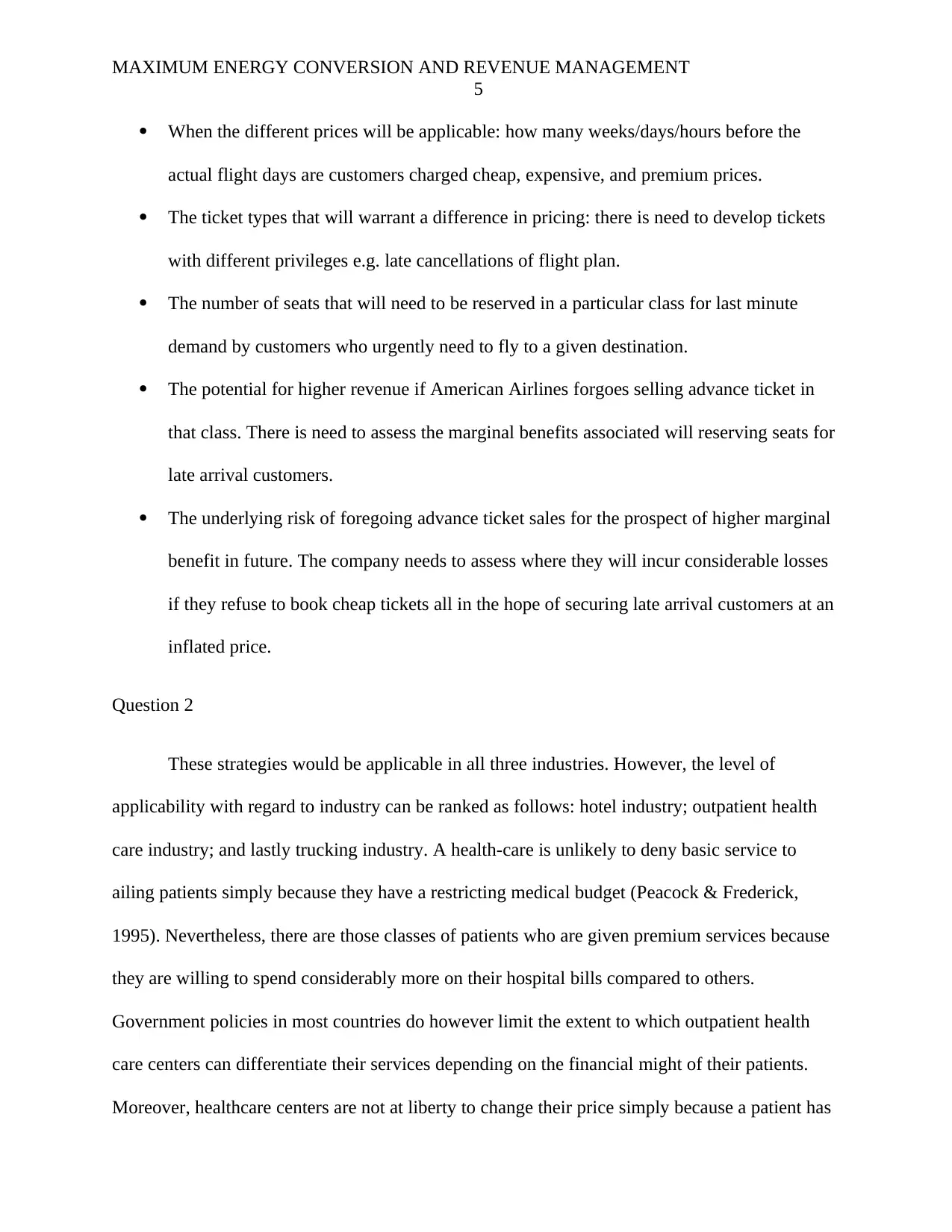
MAXIMUM ENERGY CONVERSION AND REVENUE MANAGEMENT
5
When the different prices will be applicable: how many weeks/days/hours before the
actual flight days are customers charged cheap, expensive, and premium prices.
The ticket types that will warrant a difference in pricing: there is need to develop tickets
with different privileges e.g. late cancellations of flight plan.
The number of seats that will need to be reserved in a particular class for last minute
demand by customers who urgently need to fly to a given destination.
The potential for higher revenue if American Airlines forgoes selling advance ticket in
that class. There is need to assess the marginal benefits associated will reserving seats for
late arrival customers.
The underlying risk of foregoing advance ticket sales for the prospect of higher marginal
benefit in future. The company needs to assess where they will incur considerable losses
if they refuse to book cheap tickets all in the hope of securing late arrival customers at an
inflated price.
Question 2
These strategies would be applicable in all three industries. However, the level of
applicability with regard to industry can be ranked as follows: hotel industry; outpatient health
care industry; and lastly trucking industry. A health-care is unlikely to deny basic service to
ailing patients simply because they have a restricting medical budget (Peacock & Frederick,
1995). Nevertheless, there are those classes of patients who are given premium services because
they are willing to spend considerably more on their hospital bills compared to others.
Government policies in most countries do however limit the extent to which outpatient health
care centers can differentiate their services depending on the financial might of their patients.
Moreover, healthcare centers are not at liberty to change their price simply because a patient has
5
When the different prices will be applicable: how many weeks/days/hours before the
actual flight days are customers charged cheap, expensive, and premium prices.
The ticket types that will warrant a difference in pricing: there is need to develop tickets
with different privileges e.g. late cancellations of flight plan.
The number of seats that will need to be reserved in a particular class for last minute
demand by customers who urgently need to fly to a given destination.
The potential for higher revenue if American Airlines forgoes selling advance ticket in
that class. There is need to assess the marginal benefits associated will reserving seats for
late arrival customers.
The underlying risk of foregoing advance ticket sales for the prospect of higher marginal
benefit in future. The company needs to assess where they will incur considerable losses
if they refuse to book cheap tickets all in the hope of securing late arrival customers at an
inflated price.
Question 2
These strategies would be applicable in all three industries. However, the level of
applicability with regard to industry can be ranked as follows: hotel industry; outpatient health
care industry; and lastly trucking industry. A health-care is unlikely to deny basic service to
ailing patients simply because they have a restricting medical budget (Peacock & Frederick,
1995). Nevertheless, there are those classes of patients who are given premium services because
they are willing to spend considerably more on their hospital bills compared to others.
Government policies in most countries do however limit the extent to which outpatient health
care centers can differentiate their services depending on the financial might of their patients.
Moreover, healthcare centers are not at liberty to change their price simply because a patient has
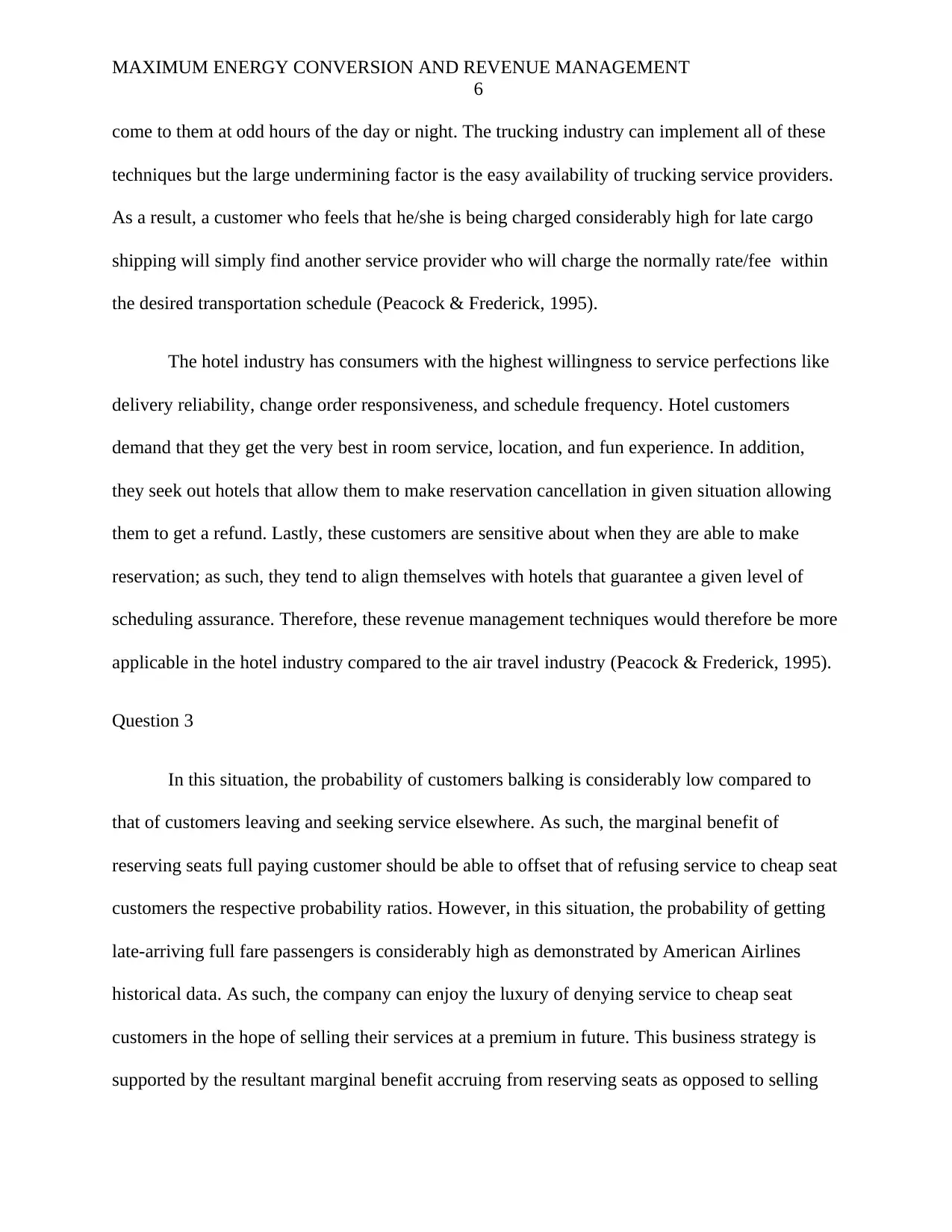
MAXIMUM ENERGY CONVERSION AND REVENUE MANAGEMENT
6
come to them at odd hours of the day or night. The trucking industry can implement all of these
techniques but the large undermining factor is the easy availability of trucking service providers.
As a result, a customer who feels that he/she is being charged considerably high for late cargo
shipping will simply find another service provider who will charge the normally rate/fee within
the desired transportation schedule (Peacock & Frederick, 1995).
The hotel industry has consumers with the highest willingness to service perfections like
delivery reliability, change order responsiveness, and schedule frequency. Hotel customers
demand that they get the very best in room service, location, and fun experience. In addition,
they seek out hotels that allow them to make reservation cancellation in given situation allowing
them to get a refund. Lastly, these customers are sensitive about when they are able to make
reservation; as such, they tend to align themselves with hotels that guarantee a given level of
scheduling assurance. Therefore, these revenue management techniques would therefore be more
applicable in the hotel industry compared to the air travel industry (Peacock & Frederick, 1995).
Question 3
In this situation, the probability of customers balking is considerably low compared to
that of customers leaving and seeking service elsewhere. As such, the marginal benefit of
reserving seats full paying customer should be able to offset that of refusing service to cheap seat
customers the respective probability ratios. However, in this situation, the probability of getting
late-arriving full fare passengers is considerably high as demonstrated by American Airlines
historical data. As such, the company can enjoy the luxury of denying service to cheap seat
customers in the hope of selling their services at a premium in future. This business strategy is
supported by the resultant marginal benefit accruing from reserving seats as opposed to selling
6
come to them at odd hours of the day or night. The trucking industry can implement all of these
techniques but the large undermining factor is the easy availability of trucking service providers.
As a result, a customer who feels that he/she is being charged considerably high for late cargo
shipping will simply find another service provider who will charge the normally rate/fee within
the desired transportation schedule (Peacock & Frederick, 1995).
The hotel industry has consumers with the highest willingness to service perfections like
delivery reliability, change order responsiveness, and schedule frequency. Hotel customers
demand that they get the very best in room service, location, and fun experience. In addition,
they seek out hotels that allow them to make reservation cancellation in given situation allowing
them to get a refund. Lastly, these customers are sensitive about when they are able to make
reservation; as such, they tend to align themselves with hotels that guarantee a given level of
scheduling assurance. Therefore, these revenue management techniques would therefore be more
applicable in the hotel industry compared to the air travel industry (Peacock & Frederick, 1995).
Question 3
In this situation, the probability of customers balking is considerably low compared to
that of customers leaving and seeking service elsewhere. As such, the marginal benefit of
reserving seats full paying customer should be able to offset that of refusing service to cheap seat
customers the respective probability ratios. However, in this situation, the probability of getting
late-arriving full fare passengers is considerably high as demonstrated by American Airlines
historical data. As such, the company can enjoy the luxury of denying service to cheap seat
customers in the hope of selling their services at a premium in future. This business strategy is
supported by the resultant marginal benefit accruing from reserving seats as opposed to selling
⊘ This is a preview!⊘
Do you want full access?
Subscribe today to unlock all pages.

Trusted by 1+ million students worldwide
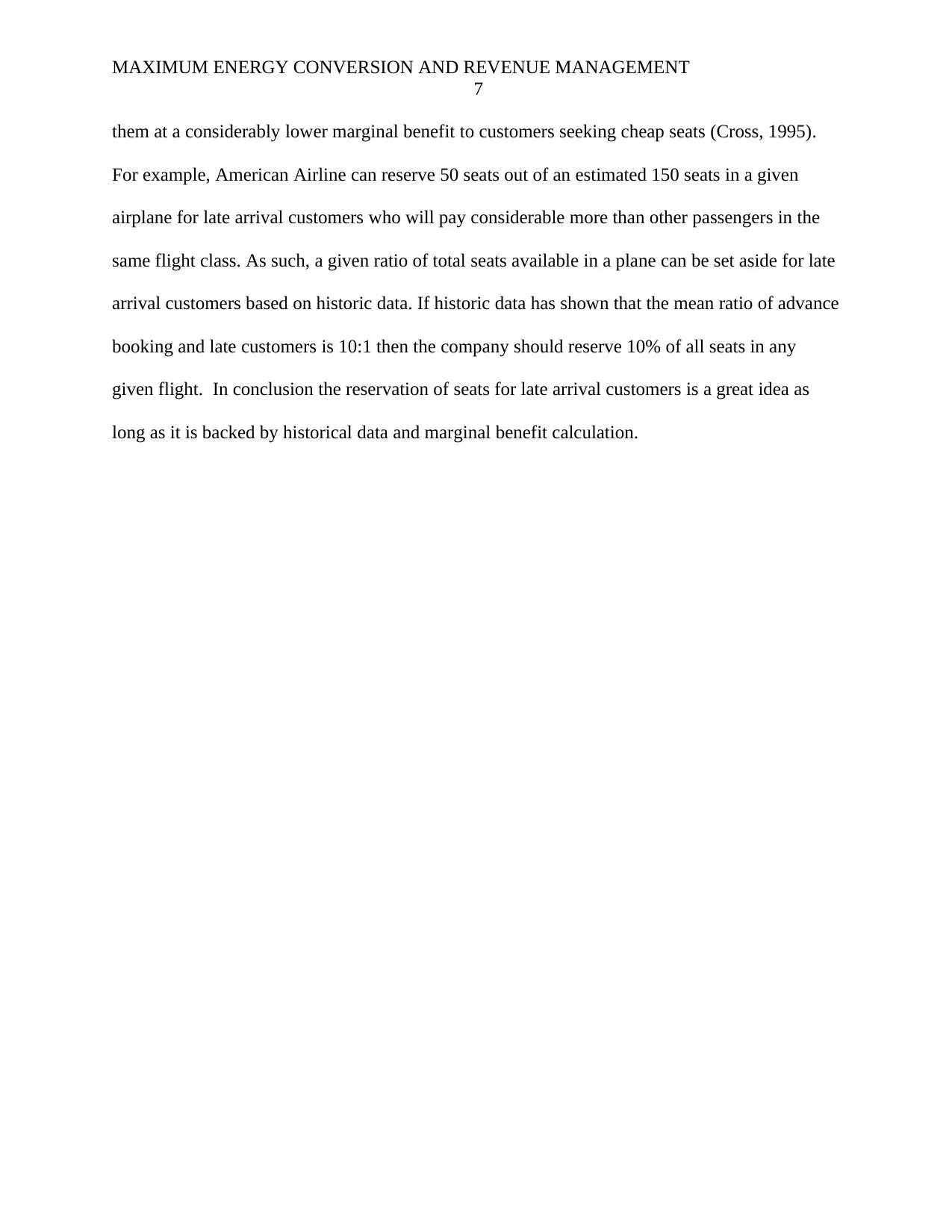
MAXIMUM ENERGY CONVERSION AND REVENUE MANAGEMENT
7
them at a considerably lower marginal benefit to customers seeking cheap seats (Cross, 1995).
For example, American Airline can reserve 50 seats out of an estimated 150 seats in a given
airplane for late arrival customers who will pay considerable more than other passengers in the
same flight class. As such, a given ratio of total seats available in a plane can be set aside for late
arrival customers based on historic data. If historic data has shown that the mean ratio of advance
booking and late customers is 10:1 then the company should reserve 10% of all seats in any
given flight. In conclusion the reservation of seats for late arrival customers is a great idea as
long as it is backed by historical data and marginal benefit calculation.
7
them at a considerably lower marginal benefit to customers seeking cheap seats (Cross, 1995).
For example, American Airline can reserve 50 seats out of an estimated 150 seats in a given
airplane for late arrival customers who will pay considerable more than other passengers in the
same flight class. As such, a given ratio of total seats available in a plane can be set aside for late
arrival customers based on historic data. If historic data has shown that the mean ratio of advance
booking and late customers is 10:1 then the company should reserve 10% of all seats in any
given flight. In conclusion the reservation of seats for late arrival customers is a great idea as
long as it is backed by historical data and marginal benefit calculation.
Paraphrase This Document
Need a fresh take? Get an instant paraphrase of this document with our AI Paraphraser
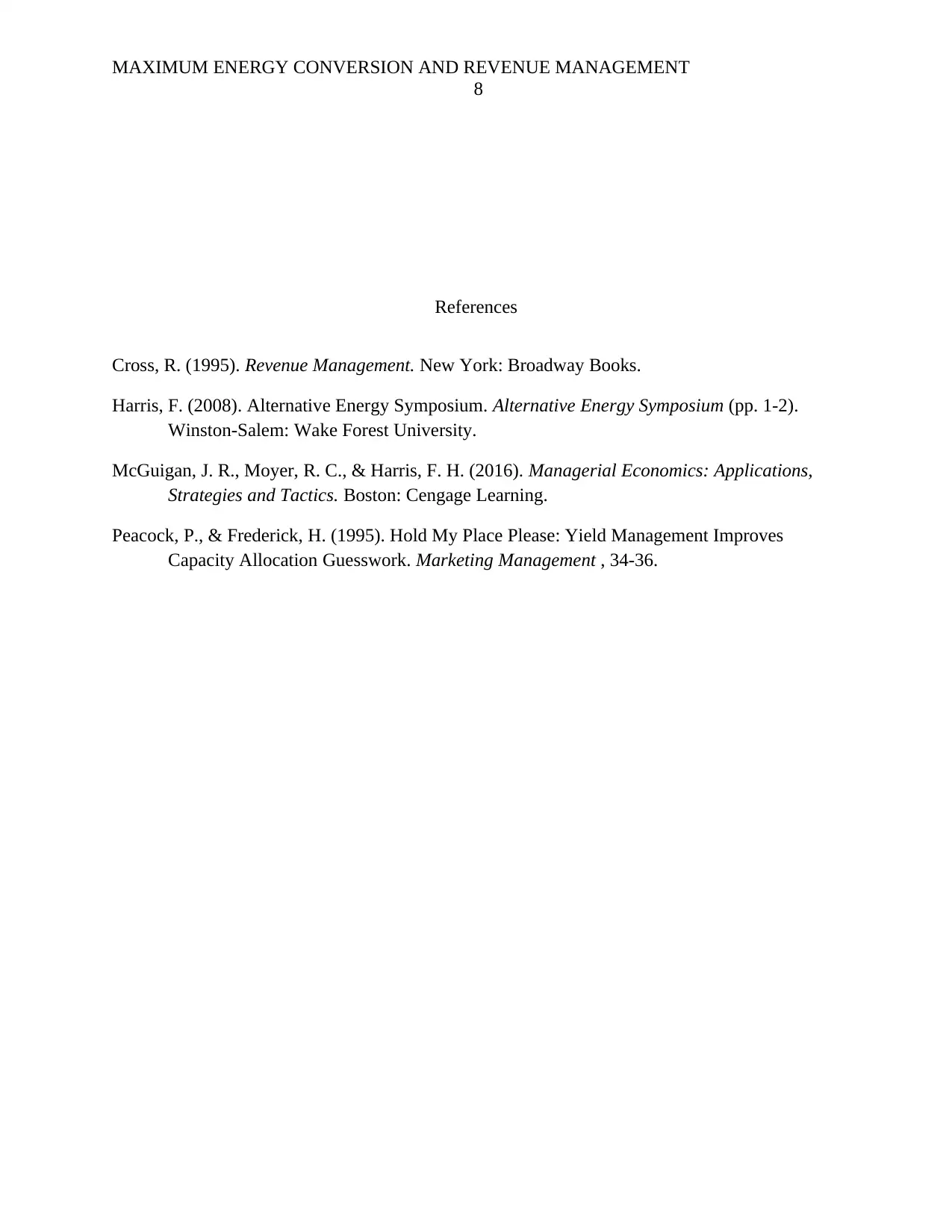
MAXIMUM ENERGY CONVERSION AND REVENUE MANAGEMENT
8
References
Cross, R. (1995). Revenue Management. New York: Broadway Books.
Harris, F. (2008). Alternative Energy Symposium. Alternative Energy Symposium (pp. 1-2).
Winston-Salem: Wake Forest University.
McGuigan, J. R., Moyer, R. C., & Harris, F. H. (2016). Managerial Economics: Applications,
Strategies and Tactics. Boston: Cengage Learning.
Peacock, P., & Frederick, H. (1995). Hold My Place Please: Yield Management Improves
Capacity Allocation Guesswork. Marketing Management , 34-36.
8
References
Cross, R. (1995). Revenue Management. New York: Broadway Books.
Harris, F. (2008). Alternative Energy Symposium. Alternative Energy Symposium (pp. 1-2).
Winston-Salem: Wake Forest University.
McGuigan, J. R., Moyer, R. C., & Harris, F. H. (2016). Managerial Economics: Applications,
Strategies and Tactics. Boston: Cengage Learning.
Peacock, P., & Frederick, H. (1995). Hold My Place Please: Yield Management Improves
Capacity Allocation Guesswork. Marketing Management , 34-36.
1 out of 8
Your All-in-One AI-Powered Toolkit for Academic Success.
+13062052269
info@desklib.com
Available 24*7 on WhatsApp / Email
![[object Object]](/_next/static/media/star-bottom.7253800d.svg)
Unlock your academic potential
Copyright © 2020–2025 A2Z Services. All Rights Reserved. Developed and managed by ZUCOL.